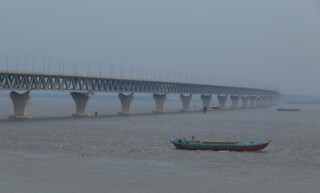The Rivers of Dhaka
Fatema Ahmed
When my parents spoke of being at university in Dhaka, some twenty years apart in the 1940s and 1960s, the city they spoke of sounded small and sleepy; a city of green spaces that was reached across many rivers from their hometowns. I couldn’t connect it at all to the noisy, gridlocked place I visited for the first time as a child in the 1980s and later as an adult; their memories seemed nostalgic and not to be relied on. My mother, who is entirely unsentimental about her youth, even described it as ‘heaven’.
I should have given her memories more credit. A city of 240,000 people in 1941, when it was still a quiet provincial capital, had more than doubled its population by 1961, and increased by a factor of ten again by the time I could visit. Today, Dhaka is a megacity and defining where it stops and who counts as an inhabitant has challenged the authorities for some time. Since 2014, the city has been divided into two very uneven portions, with the mayors of Dhaka North and South between them responsible for more than 10 million people. (The wider urban area could be home to more than double that.)
Although the population of Bangladesh has increased by 100 million since independence, Dhaka’s growth is not the result of a population explosion, at least not any more. The overall birth rate has declined so much over the last fifty years that Bangladesh is heading for replacement-level fertility in 2025. What drives two thousand people to move to the capital every day is climate change.
There’s no shortage of dire predictions for Bangladesh: the World Bank has looked at the consequences of river flooding that six to twelve million people will experience by the 2040s and the coastal flooding that will displace two to six million by the 2070s, if the country doesn’t find ways to adapt to the projected rise in average temperature. In 2021, on the list of countries vulnerable to climate change, it was ranked 168thout of 188 (the more vulnerable the country, the lower its score). The World Bank describes Bangladesh’s economic progress in the last fifty years as ‘inspiring’; it is set to be a ‘middle income’ country sometime this decade. It’s unclear, however, how far a country of 230 rivers, including the Ganges, Brahmaputra and Meghna as they flow out into the Bay of Bengal, can be expected to adapt to the effects of carbon emissions it didn’t cause – and how much of that inspiring progress will be cancelled out.
As the monsoons become more extreme and flooding increases, Bangladesh is losing agricultural land, with an IMF report in 2019 predicting that it could lose 30 per cent of its food production by 2050. There are regular reports on al-Jazeera or the BBC about the resilient Bangladeshi farmers who are turning to floating farms to continue growing crops. The Bangladesh Rice Research Institute has invented strains of rice that can be grown in saline water. But hydroponics won’t feed the whole country – or provide enough employment – and salt-tolerant rice can’t make up for the wrecking of fresh water.
Parts of Dhaka regularly flood during the monsoon season – like 80 per cent of the country, the capital is on a flood plain – but the city is sprawling and informal settlements are on the rise, particularly along the Buriganga and Balu rivers that flow to the south and east. A study last year estimated that six million people now live in Dhaka’s flood zones. The salinity that has forced so many to leave rural areas is coming to the capital, too. The city gets so much of its water by tapping into ground supplies that the ground is sinking, which leads to more flooding and increases the risk of salt entering the water supply.
A climate-change thinktank in Bangladesh has suggested that some of the internal migrants should be encouraged to move out of Dhaka, to smaller towns and cities. It’s much too late to discuss how unfair this is, so perhaps the only thing to do is add it to the list of things that a climate reparations fund ought to pay for.
Moving out of Dhaka isn’t going to save people from other environmental hazards. In January 2021, a court in Bordeaux ruled that a forty-year-old man known as Sheel could not be deported to Bangladesh because of the air pollution. His asthma was so acute and the drugs he needed so hard to get, his lawyer argued, that forcing him to return would be the same as sentencing him to death. There was a little more to the case than some of the reports suggested – Sheel had first sought and been refused political asylum in France before being granted temporary residence on health grounds – but there’s nothing ambiguous about the air pollution in Bangladesh. Sheel was from an unnamed town two hundred kilometres north of Dhaka.
The language of the IPCC, UNFCCC, IMF and World Bank is remote at the best at times, but the Bangladesh of climate-crisis reports seems impossible to reconcile with the country of poetry and folk song (even allowing for pastoral idealisation). The latter is so villagey and agricultural, so fishing and river-based, that it seemed incredible to me, growing up in a car-centric London suburb, that anyone could be so attached to it. My parents’ love of what I dismissed as ‘akash and batash’ (Bengali likes to rhyme its nouns and these are the words for sky and wind) seemed sentimental; it’s not as if they grew up on the land. But when I listen to popular songs now, they don’t seem like harmless idylls any more; they sound like science fiction.
This piece is part of the LRB’s collaboration with the World Weather Network.


Comments